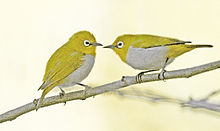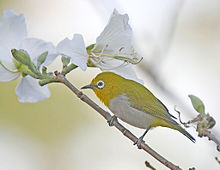- Oriental White-eye
-
Oriental White-eye 
Nominate race (most likely, but see text), Bhopal, India Conservation status Scientific classification Kingdom: Animalia Phylum: Chordata Class: Aves Order: Passeriformes Family: Zosteropidae (disputed) Genus: Zosterops Species: Z. palpebrosus Binomial name Zosterops palpebrosus
(Temminck, 1824)Synonyms Sylvia palpebrosa
Zosterops palpebrosaThe Oriental White-eye, Zosterops palpebrosus, is a small passerine bird in the white-eye family. It is a resident breeder in open woodland in tropical Asia east from India to China and Indonesia. They forage in small groups, feeding on nectar and small insects. They are easily identified by the distinctive white eye-ring and overall yellowish upperparts. Several populations of this widespread species are named subspecies and some have distinctive variations in the extent and shades of yellows in their plumage.
Contents
Description
This bird is small (about 8–9 cm long) with yellowish olive upper parts, a white eye ring, yellow throat and vent. The belly is whitish grey but may have yellow in some subspecies. The sexes look similar. The species is widespread and is part of a superspecies complex that includes Zosterops japonicus, Zosterops meyeni and possibly others. The taxonomy of the group is still unclear with some island populations being distinctive while some subspecies are not well supported. The population from Flores, Indonesia for instance is found closer to the Pale White-eye. The family itself is now questioned since they are nested along with the Stachyris babblers.[2]
About eleven subspecies are well recognized. These include the nominate form (type locality Bengal, India) which is found from Oman and Arabia, Afghanistan, northern India and extends into China and northern Myanmar. The population in the Western Ghats and hills of southern India is placed in nilgiriensis while salimalii of the Eastern Ghats hills (Shevaroy, Chitteri, Seshachalam, Nallamalai) is sometimes subsumed into the nominate race. The population of the plains of India, Laccadives and Sri Lanka are sometimes placed in egregius (= egregia) but is restricted by other works to the population in Sri Lanka.[3][4] The populations in southern Myanmar, Thailand and Laos are placed in siamensis. The Nicobar Islands form is nicobaricus and is sometimes also used for the population on the Andaman Islands which are however distinctive and a distinct unnamed population.[3] The populations from southern Thailand to western Cambodia are placed in williamsoni.[5] Other Southeast Asian island forms include auriventer (=aureiventer), buxtoni, melanurus and unicus.
Race occidentis (now often subsumed into the nominate race) of the Western Himalayas has the upper side dark green and the flanks are tinged in brown. The form salimalii has a shorter bill and is brighter yellow-green above.[3][6] Some authors consider the nominate race to be restricted to Sikkim, Bhutan, Assam and Yunnan and consider the peninsular race as occidentis[7] (or amabilis if the form from Kathiawar described by Koelz is considered valid[8]).[3]
In Sri Lanka, race egregia is smaller and has a brighter back and throat than the endemic Sri Lanka White-eye, Zosterops ceylonensis found in the central hills.
The English and scientific names refer to the conspicuous ring of white feathers round the eyes, zosterops being Greek for 'girdle-eye'.
Distribution and habitat
The species is found in a wide range of habitats from scrub to moist forest. They sometimes occur on mangrove areas such as in the Karachi area.[9] and on islands they may lead a more insectivorous life.[10] They are somewhat rare only in the drier desert regions of western India.[11]
A feral population was detected in San Diego, California in the 1980s and subsequently eradicated.[12]
Behaviour and ecology
These white-eyes are sociable, forming flocks which only separate on the approach of the breeding season. They are highly arboreal and only rarely descend to the ground. The breeding season is February to September but April is the peak breeding season[13] and the compact cup nest is a placed like a hammock on the fork of a branch. The nest is made of cobwebs, lichens and plant fibre. The nest is built in about 4 days and the two pale blue eggs[13] are laid within a couple of days of each other. The eggs hatch in about 10 days. Both sexes take care of brooding the chicks which fledge in about 10 days.[14] Though mainly insectivorous, the Oriental White-eye will also eat nectar and fruits of various kinds.[15]
They call frequently as they forage and the usual contact call is a soft nasal cheer.[3] They pollinate flower when they visit them for flower insects (such as thrips) and possibly nectar (questioned[16]) that form their diet.[17] The forehead is sometimes coloured by pollen leading to mistaken identifications.[18] They have been observed bathing in dew accumulated on leaves.[19]
Dawn song, Southern India Song of Oriental White Eye
Song of Oriental White Eye
When nesting, they may mob palm squirrels but being small birds they are usually on the defensive. Their predators include bats (esp. Megaderma lyra)[20] and birds such as the White-throated Kingfisher.[21] Endoparasitic Haemosporidia of the genus Haemoproteus and Dorisa have been isolated from the species although these rarely cause death.[22][23]
Like some other white-eyes,[24] they sometimes steal nest material from the nests of other birds.[25] Cases of interspecific feeding have been noted with white-eyes feeding the chicks of a Paradise Flycatcher.[26][27]
Although not strong fliers, they are capable of dispersing in winds and storms to new areas including offshore islands.[10] A feral population of this species established itself in California during the 1980s requiring their capture and destruction. They were captured by luring them using call playback and live decoys into mistnets.[17]
References
- ^ BirdLife International (2008). Zosterops palpebrosus. In: IUCN 2008. IUCN Red List of Threatened Species. Downloaded on 23 August 2009.
- ^ Moyle, RG; Filardi CE, Smith CE & Jared Diamond (2009). "Explosive Pleistocene diversification and hemispheric expansion of a "great speciator"". Proc. Nat. Acad. Sci. 106 (6): 1863–1868. doi:10.1073/pnas.0809861105. PMC 2644129. PMID 19181851. http://www.pubmedcentral.nih.gov/articlerender.fcgi?tool=pmcentrez&artid=2644129.
- ^ a b c d e Rasmussen PC & Anderton JC (2005). Birds of South Asia: The Ripley Guide. Volume 2. Smithsonian Institution & Lynx Edicions. p. 551.
- ^ Ali, S & S D Ripley (1999). Handbook of the birds of India and Pakistan. 10 (2 ed.). Oxford University Press. pp. 59–64. ISBN 0195620631.
- ^ Robinson, HC & C Boden Kloss. "On a new form of white-eye from Siam". Journal of the Natural History Society of Siam 3 (4): 445. http://www.archive.org/stream/journalofnatural03natu#page/445/mode/1up.
- ^ Whistler,H (1933). "Description of a new race of the White Eye Zosterops palpebrosa". J. Bombay Nat. Hist. Soc. 36 (4): 811.
- ^ Whistler, Hugh (1949). Popular handbook of Indian birds. 4th edn.. Gurney and Jackson. pp. 264–265.
- ^ Koelz, Walter (1950). "New subspecies of birds from southwestern Asia. American Museum novitates ; no. 1452". American Museum Novitates 1452. hdl:2246/4237.
- ^ Khacher,Lavkumar J (1970). "Notes on the White-eye (Zosterops palpebrosa) and Whitebreasted Kingfisher (Halcyon smyrnensis)". J. Bombay Nat. Hist. Soc. 67 (2): 333.
- ^ a b Betts,FN (1956). "Colonization of islands by White-eyes (Zosterops spp.)". J. Bombay Nat. Hist. Soc. 53 (3): 472–473.
- ^ Himmatsinhji,MK (1966). "Another bird record from Kutch". J. Bombay Nat. Hist. Soc. 63 (1): 202–203.
- ^ Minnesang D. J. (1981). Detection and retrieval of Indian White-eyes Zosterops palpebrosa palpebrosa (Temminck) in San Diego.. California Department of Food and Agriculture Detection Project Progress Report.. pp. 1–23.
- ^ a b Oates, Eugene W. (1889). Fauna of British India. Birds. Volume 1. Taylor and Francis. pp. 214–215. http://www.archive.org/details/birdsindia01oaterich.
- ^ Doyle,EE (1933). "Nesting of the White-eye (Zosterops palpebrosa Semm.)". J. Bombay Nat. Hist. Soc. 36 (2): 504–505.
- ^ Page, Wesley T. (1912). "Breeding of the Indian White-Eye". Avicultural Magazine 3 (4): 114–117. http://www.archive.org/stream/avicultural3319111912avic#page/113/mode/1up.
- ^ Moreau RE, Mary Perrins & J T Hughes. "Tongues of the Zosteropidae (White-eyes)". Ardea 57: 29–47. http://ardeajournal.natuurinfo.nl/ardeapdf/a57-029-047.pdf.
- ^ a b Van Way, Valerie (1984). The White-eyes eradication effort in California. University of Nebraska, Proceedings of the Eleventh Vertebrate Pest Conference. http://digitalcommons.unl.edu/vpc11/41.
- ^ Harington,HH (1910). "The Indian White-eye (Zosterops palpebrosa)". J. Bombay Nat. Hist. Soc. 20 (2): 520–521.
- ^ Sundar, K. S. G.; Chanda, J. (2002). "Foliage-dew bathing in oriental white-eye Zosterops palpebrosus, Family Zosteropidae". J. Bombay Nat. Hist. Soc. 99 (2): 318–319.
- ^ Green,E Ernest (1907). "Do bats capture and eat birds?". J. Bombay Nat. Hist. Soc. 17 (3): 835–836.
- ^ Sen, SN (1944). "Food of the White-breasted Kingfisher (Halcyon smyrnensis fusca)". J. Bombay Nat. Hist. Soc. 44: 475.
- ^ Chakravarty, Mukundamurari & Amiya Bhusan Kar (1945). "Studies on Hæmosporidia from Indian birds—Series II". Proceedings: Plant Sciences 22 (2): 63–69. doi:10.1007/BF03049879 (inactive 2010-03-17).
- ^ Ray, H.N. and Sarkar, A.C. (1967). "On some new coccidia from the Indian passerine birds, Zosterops palpebrosa (Temm.), Lonchura malabarica (Linn.), L. punctulata (Linn.) and Passer domesticus (Linn.)". Proceedings of the 54th Indian Science Congress 54: 448–449.
- ^ Guest, Sandra J (1973) (PDF). A reproductive biology and natural history of the Japanese white-eye (Zosterops japonica japonica) in urban Oahu. US International Biological Program. http://www.botany.hawaii.edu/faculty/duffy/ibp/29.pdf.
- ^ Mahesh SS, Shyamal L & Vinod Thomas (2010). "Nest material kleptoparasitism by the Oriental White-eye Zosterops palpebrosus". Indian Birds 6 (1): 22–23.
- ^ Tehsin, Raza H & Himalay Tehsin (1998). "White-eye (Zosterops palpebrosa) feeding the chicks of paradise flycatcher (Terpsiphone paradisi)". J. Bombay Nat. Hist. Soc 95 (2): 348.
- ^ Balar, R. (2008). "Interspecific feeding of Asian Paradise-Flycatcher Terpsiphone paradisi nestlings by Oriental White-eye Zosterops palpebrosus". Indian Birds 4: 163–164.
External links
- Oriental White-eye videos, photos & sounds on the Internet Bird Collection.
Categories:- IUCN Red List least concern species
- Zosterops
- Birds of Asia
Wikimedia Foundation. 2010.









